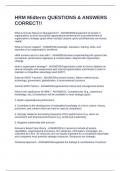HRM Midterm QUESTIONS & ANSWERS
CORRECT!!
What is Human Resource Management? - ANSWERSManagement of people in
organizations to drive successful organizational performance and achievement of
organization's strategic goals which includes acquire, grow and effectively use human
capital.
What is Human Capital? - ANSWERSKnowledge, education, training, skills, and
expertise of an organization's workforce
HRM involves and is in line with? - ANSWERSInvolves implementing HR systems like
recruitment, performance appraisal, & compensation. Aligned with organization
strategy.
what is organization strategy? - ANSWERSOrganization's plan for how to balance its
internal strengths and weaknesses with external opportunities and threats in order to
maintain a competitive advantage used SWOT.
External SWOT Facotors - ANSWERSeconomic factors, labour market issues,
technology, government, globalization, & environmental concerns
Internal SWOT factors - ANSWERSorganizational culture and management factors
What is the significance of HRM? - ANSWERS1. Competencies (e.g., experience,
knowledge, etc.) & behaviours will be available to meet strategic goals.
2. Better organizational performance.
3. Contribute to the development of embedded knowledge of a firm's culture, history,
processes, and context which are hard to copy by competitors.
4. Strongly related to accounting measures of firm performance (e.g. return on
investment) and financial performance (e.g. profit) and productivity.
5. Negative relationship with turnover.
Resource Based View theory - ANSWERSFirm resources include all assets,
capabilities, organizational processes, firm attributes, information, knowledge, etc.,
controlled by a firm. All resources are not equally important for a competitive advantage
and companies must prioritize strategic resources. Resources are strategic.
Dictatorial approach - ANSWERSDisregarded the feelings & contributions of workers.
,Phase 1- Early 1900's - ANSWERScompanies expanding rapidly need for specialized
units to manage HR increased to hire new employees - selection, interview, etc.. and
Manage existing workforce - training, compensation, etc. which is the personnel
department.
personnel department - ANSWERSSelf-contained and handled simple human resource
activities - hiring, pay, and benefits, etc.
Phase 2 1930s-1950s - ANSWERSIncrease in operational efficiencies - production of
goods but wages did not keep up. The rise of large labor unions
Worker rights and legislation passages.
1. The National Labor Relations Act in 1935- Union procedures
Businesses must have personnel managers represent the interests of business to
organized labor (i.e. union)
2. The Fair Labor Standards Act in 1938
Established a minimum wage
Phase 3 1960s-1980s - ANSWERSIncrease in workplace legislations in the 60s 70s
and 80s which covered human rights, wages, benefits, working conditions, health and
safety areas.
The Civil Rights Act of 1964 banned discrimination based on race, color, religion, sex &
national origin. Ended unequal application of racial segregation in Schools, Workplaces,
Public facilities
Personnel managers role expanded to include knowledge on legislation laws, human
rights, wages, benefits, working conditions, health & safety issues Effects the workforce
"Personnel Management" to "Human Resources Management". No more maintenance
& administration BUT corporate contribution proactive strategy for the organization OR
Positive force for the organization
Phase 4 Current Phase - ANSWERSUnderstanding of:
1. Human Resources Management
2. HR department role in organizations- HR departments and HR professionals and
management of people through HR programs and policies to ensure:
a. Employee performance
b. Profitability and organizational survival
c. Customer satisfaction
, Responsibilities of HR professionals - ANSWERS1. Align HR strategies with business
strategies. E.g. Determine number of employees specific units needs based on overall
goal of the organization - Job Analysis.
2. Delivering services like:
Provide appropriate information to job candidate(s), information about services (e.g.,
pension), advertising, recruitment policies and training efforts, and administrative
matters.
3. Strengthen employee contributions through policy formulation and implementation for
better work environment - e.g. money allocated to ergonomic needs and technology:
E.g., Health & safety (e.g. WHMIS training), Workplace harassment.
4. Manage change/change agents.
5. HR professionals are "in-house consultants" and subject matter experts- In
partnership with line managers or non-HR professionals.
Line managers and non-HR Personnel - ANSWERSHR activities have become
prevalent in organizations E.g., accounting, nursing, physical plant supervisor, etc. They
make hiring decisions, Qualifications, Person-organization fit, Determine work and job
design, Promote a culture of well-being, E.g. Alleviate stressors, Coach & develop
employees, E.g. Strong interpersonal relations, and Performance review Feedback &
work direction. HR activities do not solely lie with the HR professionals but do not
understand the nuances of different aspects of HR e.g., legislations. Successful
management of HR is a partnership between line manager (or non HR professional)
and the HR personnel.
Growing professionalism of HR - ANSWERS1. External perception as a professional:
Profession is recognized thru certification. E.g., the Human Resources Professionals
Association (HRPA) is the regulatory authority for human resource (HR) professionals in
Ontario. It is a three-tiered designation
A. Certified Human Resource Professional (CHRP- Entry Level)
B. Certified Human Resource Leader (CHRL)
C. Certified Human Resource Executive (CHRE). The Certification is administered
through provinces
2. Common body of knowledge: Agreement on subject matter content: Sufficient
knowledge and skills to perform occupational actives at level of competence that is
required to protect the public interest. Has required training credentials recognized
knowledge base and/ experiences Five (5) critical pieces of knowledge-Business
acumen, Employment law and legislation, Talent management, and Broad HR
knowledge, Employee labour-relations knowledge.
3. Professionals must maintain and/or update skills: Ongoing skill development and
maintenance of professional competence




